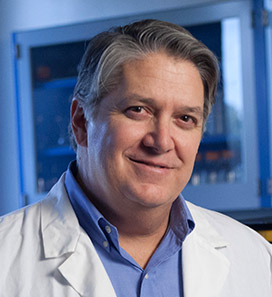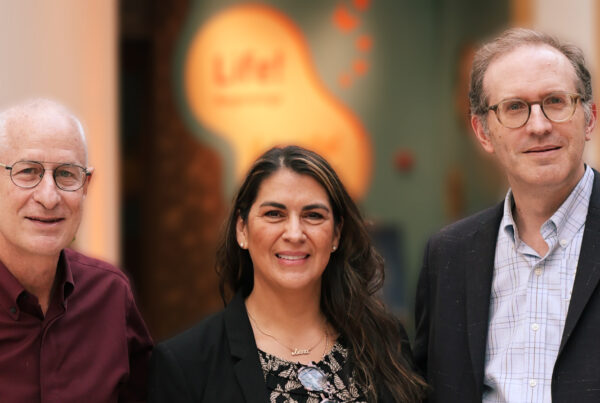
Professor Christian Pike
More than 5 million Americans are currently estimated to be living with Alzheimer’s disease. And while aging is the single greatest risk factor for developing the disease, nearly two out of every three people afflicted are women.
USC Leonard Davis School of Gerontology Professor Christian Pike studies this disparity from several angles, including examining a gene variant called apolipoprotein-E 4, or APOE4. Anyone with APOE4 is at greater risk for Alzheimer’s compared with people with other versions of the gene. But women with APOE4 are impacted more than men.
“So right now, a main area of focus in my laboratory is looking at what APOE4 is doing and comparing that between males and females to give us a little bit of insight into why it’s affecting women more,” Pike says in the latest episode of the Lessons in Lifespan Health podcast. “That can give us insight into how to develop strategies to stop it.”
Pike reports that Alzheimer’s disease risk increases with the age-related decline of estrogen in women and testosterone in men. He is leading studies on APOE4 and estrogen loss just before menopause. But he also wants to take a step back to our earliest stages of development to better understand hormones, male and female brains, and how they might interact with APOE4.
“So one of the main areas we’ve been thinking about is rethinking sex differences as not just being age-related loss of hormones but rather during very early development, which begins in utero and then shortly after birth,” he says. “As the body begins to develop into a male versus a female, the brain also becomes more male-like or more female-like.”
One of Pike’s projects is a twin study being conducted in collaboration with USC Professor of Psychology, Gerontology, and Preventive Medicine Margy Gatz that looks at whether the male- or femaleness of one’s in-utero environment can impact the risk for Alzheimer’s.
“If you’re a woman and you are a fraternal twin, if you had a sister, then they the whole environment would be relatively more feminine and if that would make you a brand relatively more feminine and you might be at greater risk,” Pike explains. “Conversely, if you had a brother, you’d be slightly more masculine and that might give you some protection against the disease further. You can then back up and say, ‘well, what’s your genotype? Are you APOE3 or APOE4?’”
Pike is also leading parallel lab studies modifying levels of male and female hormones in mice with APOE3 or APOE4.
“If we make just a very brief manipulation during critical periods of development, what happens now when those animals are adults and they develop pathology and cognitive disturbances, very much like Alzheimer’s disease?” he says. “We already know that those mice with the APOE4 gene have worse pathology. The females with APOE4 have the greatest amount of pathology, and males with APOE3 have the least amount of pathology. Can we push those relationships by just tweaking the levels of hormones during a very early window?”
If Pike turns out to be correct that differences in women’s brains make them more susceptible to the effects of APOE4, his next question is to understand why.
“What we think is going on is that APOE4 is really important in regulating the function of the brain’s immune cells called microglial cells,” he says. “What we know is that if you have APOE4, you are more likely to respond to different immune challenges with a greater inflammatory response. And these sorts of immune challenges and inflammatory responses are implicated in development of Alzheimer’s disease.”
Much of Pike’s work highlights just how little research has been done on differences between males and females. One issue is that research subjects have historically been male in an attempt for “simplicity,” he says.
“There are so many differences between men and women in Alzheimer’s disease,” he says. “I mean, at the core of it, the disease is very much the same across all people. But then when you began to break it down into the effects of different risk factors, you began to see significant differences. … And maybe we should consider that in terms of the risk factors for developing it and even how we approach it therapeutically.”
Pike’s approach to looking at early development may also help lead to new ways of thinking about treatment and prevention – ones that begin before Alzheimer’s disease starts to develop.
“If you look at clinical trials of Alzheimer’s disease drugs, almost all of them are failed. … I think one of the reasons that many in the field, including myself, believe is that we might be having the correct targets, like reducing the amount of beta amyloid and reducing the amount of tau, but we’ve historically been starting these clinical trials when the patients already have early-stage disease. By that time the brains are already full of plaques and tangles,” he says. “What needs to be done in what is starting to be done is finding people who are at high risk – people who have two copies of APOE4, for example – and beginning treatments on them in their forties or fifties, because we have evidence that the underlying pathology starts a couple of decades before the clinical manifestation.”
In the meantime, Pike says there are steps we can all take to keep our brains and bodies healthy, such as eating a Mediterranean-style diet, exercising regularly, doing cognitively challenging activities, and getting enough sleep.
“You can’t control your genetics. At least you can’t yet. But you can control your environment and your lifestyle, what we call modifiable risk factors,” Pike says. “And so what everybody can do is deal with those now while we’re waiting to get the treatments.”
To listen and learn more, check out the Lessons in Lifespan Health podcast.





